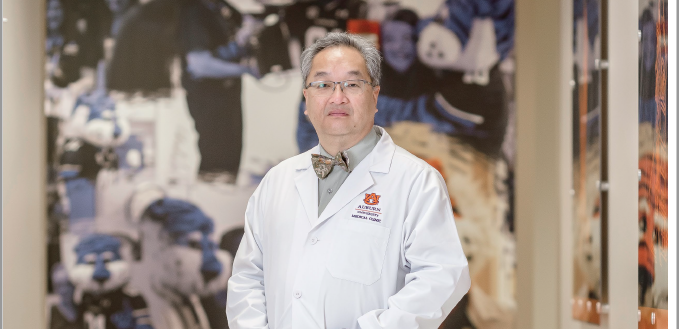When Dr. Frederick Kam was 9 years old living in Trinidad, West Indies, his mother became seriously ill after a hysterectomy, developing complications with concerns she was going to die. Although he was not allowed in the hospital, Kam’s father sneaked him in to see his mother. As he stood at the end of his mother’s bed seeing her with an IV on both arms and a tube down her nose, he felt totally helpless. After leaving the hospital, Kam decided he never wanted to feel that helpless again and that he had to become a doctor.
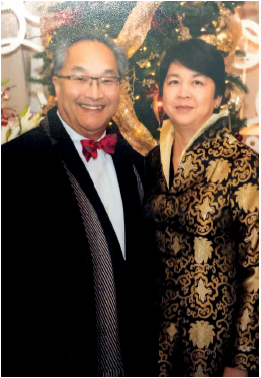
Dr. Kam has served as the director of the Auburn University Medical Clinic since 1997. Under his leadership, the clinic has grown significantly from seeing 18,000 patients a year to over 45,000 last year. On Jan. 9 when Dr. Kam learned of the unknown pneumonia situation in China, he prepared for a pandemic by ordering additional necessary medical supplies, leading the clinic to become instrumental locally in the Covid fight. The clinic became one of the first, if not the first, in the state to provide rapid testing.
Kam took his first steps to become a physician at 15 years of age when he was sent to attend high school in England. After high school, he enrolled at the University of Miami where he received his undergraduate and medical degree. Kam served as president of his medical school class and was chosen by his peers as one of the Best Doctors in America. He completed his internship at the University of Miami and was asked to join the faculty at the medical school where he received the Eric Reiss Award for Outstanding Teaching.
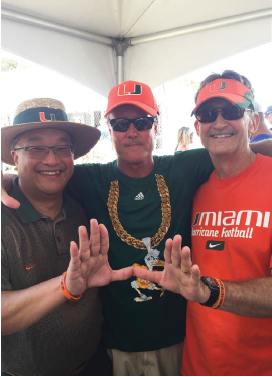
Six years later, Dr. Kam went to work for a private corporation, which led him to Auburn. His first visit to Auburn was in 1992, as a speaker at the Southern College Health Association meeting. When the Drake Center was outsourced, he returned to Auburn with the Collegiate Healthcare Company to lead the transition team for the takeover of the center in Oct. 1996. The center became the Auburn University Medical Clinic.
Dr. Kam was coming to Auburn every other week for three months. “I fell in love with the town and the people,” he says. “At the time, my wife and I were living in Miami with small children and thought Auburn was a great place to live and raise children.”
They moved to Auburn in July 1997 for Dr. Kam to become the director of the AU Medical Clinic. “I have never regretted that decision,” he says. “In the early years there were multiple attempts to recruit me to other medical centers. Auburn was where I felt we needed to be as a family.
“From the day I arrived, I worked to put together a great team,” he adds. “I hired an incredible head nurse, Mina Jeffers, to help lead the team. She was key to success of the clinic and its growth in the early years.” When he took over as director, the clinic was only available to students. He changed it to be open
to students, faculty, staff and the community since there was a shortage of primary care doctors in the area at that time.
“We have grown significantly,” adds Dr. Kam. “I have been blessed to recruit and maintain good healthcare doctors, nurse practitioners, physician assistants and a great support team. My goal was to have a comprehensive delivery process to keep people out of the hospital and the emergency room. We were successful at
that.”
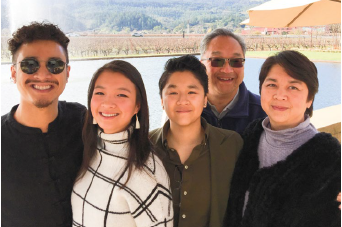 Currently with Dr. Kam there are four physicians, seven advance practice providers, four physician assistants and three nurse practitioners. Prior to Covid, the clinic was seeing 250 people a day. While the clinic began Covid testing after spring break, the numbers for testing jumped as high as 300 a day once rapid testing began June 5. It was a game changer having the rapid tests where results are available in two hours or less. Other Covid testing was taking days. In June they were the only entity that had rapid tests in the area and maybe the state.
Currently with Dr. Kam there are four physicians, seven advance practice providers, four physician assistants and three nurse practitioners. Prior to Covid, the clinic was seeing 250 people a day. While the clinic began Covid testing after spring break, the numbers for testing jumped as high as 300 a day once rapid testing began June 5. It was a game changer having the rapid tests where results are available in two hours or less. Other Covid testing was taking days. In June they were the only entity that had rapid tests in the area and maybe the state.
With the support of Auburn University, the clinic provided a drive-through testing center at the first floor of the south quad parking deck. People didn’t have to get out of their car. The rapid testing then became available through EAMC and the pediatric clinic in Opelika. “We encourage rapid tests,” states Dr. Kam, “because the earlier someone can get the results, the sooner they can make decisions about quarantine. “We were able to help businesses because there was a time when businesses couldn’t find anywhere to get their employees tested,” he adds. “We tried to fill that void. We were able to help a number of businesses in town to open and remain open.”
The clinic had plenty of masks, face shields and gowns in stock. Dr. Kam had planned to be ready if there was a flu pandemic. He increased their supply in early January when he became concerned about the virus in China. He had his current head nurse, Lisa Harmon, order as many n95 masks, gowns, gloves, hand sanitizer and disinfectant wipes as possible. Since there was not a demand at that time, the suppliers had everything in stock. The clinic never ran short of supplies.
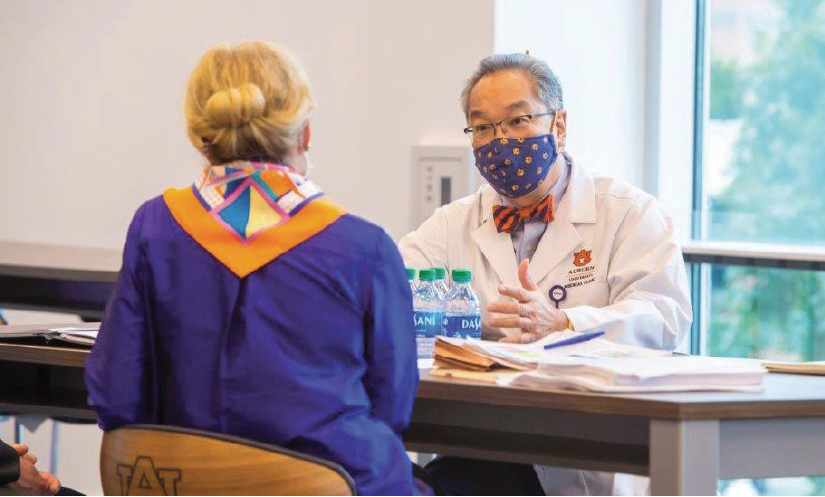
Dr. Kam and his team also began conducting telehealth visits over the phone or computer. “When Covid came on the scene every- thing else didn’t leave,” he says. “We still have people with health issues and injuries. We were still managing to handle those problems.
“My team has never shut down. Most of what we do cannot be done remotely.” When students returned in August, the clinic saw a significant spike in Covid cases, which they were expecting. “We saw two weeks of spikes,” Dr. Kam says, “but with none requiring being hospitalized since they were young and healthy. We had over 500 cases a week for a while. We had plans in place and were prepared.
“The key factor we have no control over is individual behavior. We are dealing with an unprecedented situation with Covid, so there is no playbook to go by. We have to make the playbook.” The clinic is preparing for winter and spring. “This virus is going to continue to impact us for the next few years with or without a vaccine,” believes Dr. Kim. “We are going to be challenged because like other vaccines everyone won’t take it. Bottom line is the virus will
still be here.
“My opinion is that we need to learn to live with the virus because it is going to continue to impact us no matter what we do. Vulnerable people will continue to be vulnerable. We can- not make any place safe. We can only make it safer.”
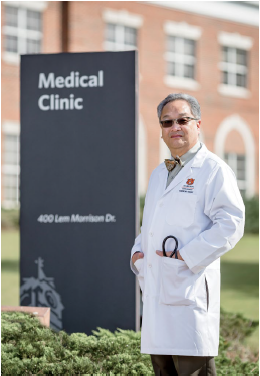
To get the virus behind us, he feels people should be individually accountable for their behavior and to implement what science has proven. Science has shown the most effective preventable method is wearing masks. This is a respiratory virus that is spread by respiratory means. If people consistently wear masks outdoors and indoors, it will significantly reduce the spread of this virus. Along with wearing masks, other prevention measures are keeping at least six feet distance, sanitizing hands and avoiding crowds. “We are seeing a lower death rate now because we implemented more of the science to help us,” he says.
“Another unique thing about this virus is that 40 to 80 percent of people who get it are totally asymptomatic. They never have a symptom. The virus has one mission, which is to find someone who is not infected and infect them.”
The way Covid patients are treated today is different from February and March. “Science has told us we need to be less aggressive in putting people on ventilators,” he states. “Medications are being utilized to prevent patients from getting worse. We limit people from going into nursing homes where people are vulnerable.
“We should not approach Thanksgiving and Christmas as we have every year,” he stresses. “The thinking should be what can we do to make our family gathering safer. Set up more things outdoors. We need to do more to protect grandparents and those with underlying health issues. People visiting family should get tested as near departure time as possible.
“I approach everyone as if they are infected. I am not shaking hands or hugging anybody other than family who live in my house. If they do anything that increases risk, I require masks indoors.”
While Dr. Kam and his team continue the Covid-19 fight, they appreciate the community. “I want people to know that my team and I are extremely appreciative and thankful of those who have shown their appreciation pro- viding lunch, cookies, smoothies, doughnuts and pizza,” expresses Dr. Kam. “We do not take that lightly.”

